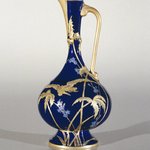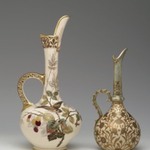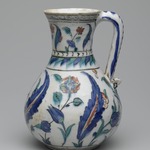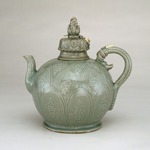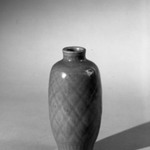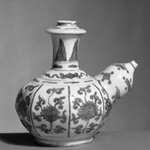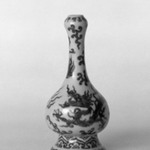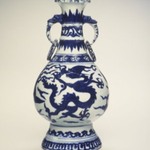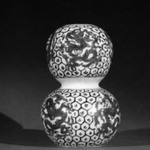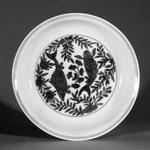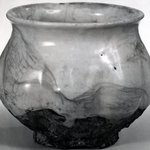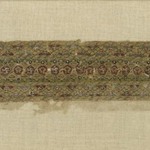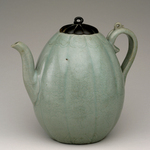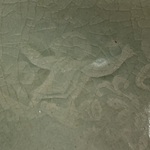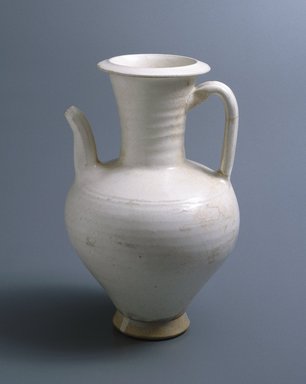
Julu Xian Ewer
Asian Art
According to historical records, the Yellow River flooded the region of Julu county in southern Hebei province on September 10, 1108. Like the ancient city of Pompeii, which was buried in 79 C.E. by ash after the eruption of Mount Vesuvius, the Julu marketplace was buried until the 1930s, when farmers discovered it while digging a well. The site was rich in Cizhouware ceramics used as daily vessels by the burgeoning Song merchant class. White Cizhou wares imitated the more luxurious ivory-white Ding ware used by elite Confucian bureaucrats. A distinctive feature of Juluxian ceramics is the pale red-brown crackle covering part of the interior of the neck and exterior of this vessel, evidence of burial in the iron-rich silt from the Yellow River.
MEDIUM
Earthenware, white slip and transparent glaze
DATES
early 12th century
DYNASTY
Song Dynasty
PERIOD
Song Dynasty
DIMENSIONS
10 x 6 3/8 in. (25.4 x 16.2 cm) (show scale)



COLLECTIONS
Asian Art
ACCESSION NUMBER
1993.55
CREDIT LINE
Gift of the Asian Art Council
CATALOGUE DESCRIPTION
This exemplary Cizhou ewer, although unsigned, conforms to the Julu Xian type with ovoid horizontally ribbed body, high wide shoulder narrowing to small base; long slender ribbed neck with everted mouth; long slightly curved vertically ribbed spout on the shoulder; grooved strap handle attached to the shoulder and top of the neck opposite the spout; and a flaring foot. It is made of a coarse, pale, gray clay which is coated with white slip to enhance its appearance. A transparent glaze is then applied. The pale brown crackle, covering half of the interior of the neck and the entire exterior of vessel to the unglazed foot, is evidence of water damage from the time of the flood and as such these characteristics exemplify the Northern Song Cizhou white glaze method as seen in Juluxian wares. The present ewer can be traced to the Cizhou kiln of Hebei and dated ca. 1108 or earlier. Julu Xian, located in Hebei Province. In 1108 a flood buried the entire region which remained undiscovered until the 1930s.
MUSEUM LOCATION
This item is not on view
CAPTION
Julu Xian Ewer, early 12th century. Earthenware, white slip and transparent glaze, 10 x 6 3/8 in. (25.4 x 16.2 cm). Brooklyn Museum, Gift of the Asian Art Council, 1993.55. Creative Commons-BY (Photo: Brooklyn Museum, 1993.55_SL1.jpg)
IMAGE
overall, 1993.55_SL1.jpg. Brooklyn Museum photograph
"CUR" at the beginning of an image file name means that the image was created by a curatorial staff member. These study images may be digital point-and-shoot photographs, when we don\'t yet have high-quality studio photography, or they may be scans of older negatives, slides, or photographic prints, providing historical documentation of the object.
RIGHTS STATEMENT
Creative Commons-BY
You may download and use Brooklyn Museum images of this three-dimensional work in accordance with a Creative Commons license. Fair use, as understood under the United States Copyright Act, may also apply.
Please include caption information from this page and credit the Brooklyn Museum. If you need a high resolution file, please fill out our online application form (charges apply).
For further information about copyright, we recommend resources at the United States Library of Congress, Cornell University, Copyright and Cultural Institutions: Guidelines for U.S. Libraries, Archives, and Museums, and Copyright Watch.
For more information about the Museum's rights project, including how rights types are assigned, please see our blog posts on copyright.
If you have any information regarding this work and rights to it, please contact copyright@brooklynmuseum.org.
RECORD COMPLETENESS
Not every record you will find here is complete. More information is available for some works than for others, and some entries have been updated more recently. Records are frequently reviewed and revised, and we welcome any additional information you might have.
